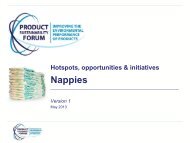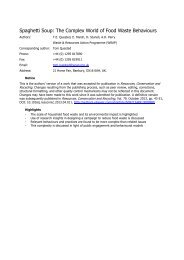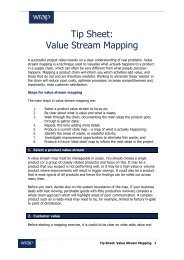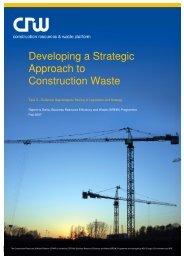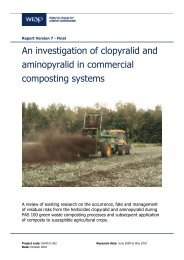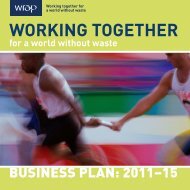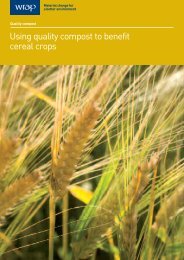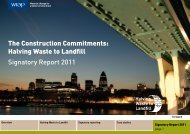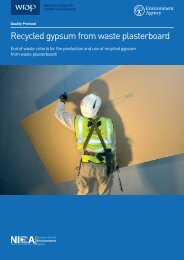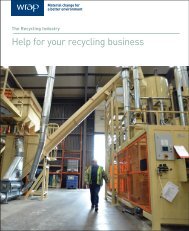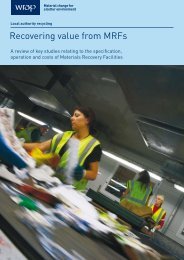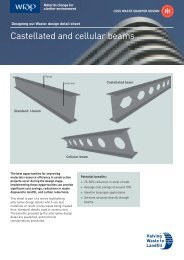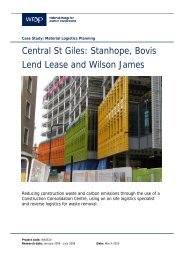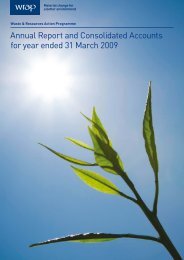Mineral wool composite panels - Wrap
Mineral wool composite panels - Wrap
Mineral wool composite panels - Wrap
Create successful ePaper yourself
Turn your PDF publications into a flip-book with our unique Google optimized e-Paper software.
Case Study: <strong>Mineral</strong> Wool/Steel Composite Panel Recycling<br />
Recycling of <strong>Mineral</strong> Wool<br />
Composite Panels Into New Raw<br />
Materials<br />
Eurobond have developed a method for recycling mineral <strong>wool</strong><br />
<strong>composite</strong> <strong>panels</strong>. By segregating the panel into constituent materials<br />
(mineral <strong>wool</strong> and steel), these can be fully and independently recycled<br />
so that new complete <strong>panels</strong> can be made and waste diverted from<br />
landfill.<br />
Project code: EMR002-000<br />
Research date: 15 Feb 2007 – 28 March 2008 Date: 28 March 2008
WRAP helps individuals, businesses and<br />
local authorities to reduce waste and<br />
recycle more, making better use of<br />
resources and helping to tackle climate<br />
change.<br />
Written by: BRE/Eurobond<br />
Front cover photography: Composite panel being fed into a <strong>composite</strong> panel recycling machine (Eurobond)<br />
WRAP and BRE believe the content of this report to be correct as at the date of writing. However, factors such as prices, levels of recycled content and regulatory<br />
requirements are subject to change and users of the report should check with their suppliers to confirm the current situation. In addition, care should be taken in using<br />
any of the cost information provided as it is based upon numerous project-specific assumptions (such as scale, location, tender context, etc.).<br />
The report does not claim to be exhaustive, nor does it claim to cover all relevant products and specifications available on the market. While steps have been taken to<br />
ensure accuracy, WRAP cannot accept responsibility or be held liable to any person for any loss or damage arising out of or in connection with this information being<br />
inaccurate, incomplete or misleading. It is the responsibility of the potential user of a material or product to consult with the supplier or manufacturer and ascertain<br />
whether a particular product will satisfy their specific requirements. The listing or featuring of a particular product or company does not constitute an endorsement by<br />
WRAP and WRAP cannot guarantee the performance of individual products or materials. This material is copyrighted. It may be reproduced free of charge subject to the<br />
material being accurate and not used in a misleading context. The source of the material must be identified and the copyright status acknowledged. This material must<br />
not be used to endorse or used to suggest WRAP’s endorsement of a commercial product or service. For more detail, please refer to WRAP’s Terms & Conditions on its<br />
web site: www.wrap.org.uk.
Executive summary<br />
This case study describes the recycling of <strong>composite</strong> sandwich <strong>panels</strong>, comprising mineral <strong>wool</strong> and steel facings,<br />
following the refurbishment of a computer data centre for Goldman Sachs Investment Bank. 17000m 2 of wall and<br />
ceiling <strong>composite</strong> <strong>panels</strong> were installed on the data centre in East Grinstead, Sussex. The <strong>composite</strong>, derived from<br />
door way cut-outs, off-cuts and site-damaged <strong>panels</strong>, comprised of approximately 1,800m 2 which was reprocessed<br />
into new raw materials (steel and mineral <strong>wool</strong>).<br />
Recycling of <strong>Mineral</strong> Wool Composite Panels Into New Raw Materials 1
Contents<br />
1.0 Background .............................................................................................................................. 3<br />
1.1 General information on the recycling project ...........................................................................3<br />
1.2 Description of the recycling project.........................................................................................3<br />
1.3 Cost benefits .........................................................................................................................4<br />
1.4 Environmental benefits ..........................................................................................................4<br />
2.0 Specific Details of the Recycling Methodology ........................................................................ 5<br />
2.1 Overview ..............................................................................................................................5<br />
2.2 Segregation ..........................................................................................................................5<br />
2.3 Delivery to the recycling site ..................................................................................................5<br />
2.4 Recycling ..............................................................................................................................6<br />
3.0 End Use .................................................................................................................................... 9<br />
3.1 Reprocessing back into steel/mineral <strong>wool</strong> product ..................................................................9<br />
4.0<br />
3.2 Reprocessing <strong>panels</strong> back into mineral <strong>wool</strong> and steel .............................................................9<br />
Conclusions .............................................................................................................................. 9<br />
5.0 References ............................................................................................................................. 10<br />
Recycling of <strong>Mineral</strong> Wool Composite Panels Into New Raw Materials 2
1.0 Background<br />
1.1 General information on the recycling project<br />
• Name: Data Centre for Goldman Sachs Investment Bank.<br />
• Region: East Grinstead, Sussex, England.<br />
• Type of recycling activity: <strong>Mineral</strong> <strong>wool</strong> <strong>composite</strong> <strong>panels</strong> collected, shredded and separated for<br />
re-entering into the manufacturing process to make new products (steel and mineral <strong>wool</strong>).<br />
• Whether new build, refurbishment or demolition: Refurbishment of data centre.<br />
• Type of material accepted: The recycling process accepts mineral <strong>wool</strong> <strong>composite</strong> <strong>panels</strong> from site<br />
demolition or refurbishment waste, site waste from new build and waste from manufacturing processes.<br />
• Use/application(s) of the material(s): Scrap steel and mineral <strong>wool</strong> raw materials are produced<br />
which are suitable for a range of products including, potentially, new <strong>composite</strong> <strong>panels</strong>.<br />
• Timescale: During 2008.<br />
• Client for the trial: Eurobond Laminates Limited.<br />
• Contractor: Laing O’Rourke (main contractor); CPS (panel sub-contractor).<br />
• Strategic partners: GD Environmental Services Ltd, Rock<strong>wool</strong> International and Corus.<br />
1.2 Description of the recycling project<br />
1,800 m 2 of Eurobond’s Firemaster wall and ceiling <strong>composite</strong> <strong>panels</strong> (100mm and 150mm thickness), which are<br />
faced with Corus’ steel ‘Performa’ product, were removed from Goldman Sachs’ data centre in East Grinstead,<br />
Sussex. The recyclate, derived from door way cut-outs, off-cuts and site-damaged <strong>panels</strong> were re-processed into<br />
new raw materials (steel and mineral <strong>wool</strong>).<br />
Construction generates more than one third of waste materials going to landfill in the UK but only half of<br />
construction and demolition waste is reused or recycled within the sector 1 . There is a growing realisation that the<br />
current model of development is unsustainable; habits must change and progress made if growth is to be<br />
sustainable. The Government recognises this and is committed to achieving sustainable development in the<br />
United Kingdom through its ‘Sustainable Construction Strategy’. Government and industry have proposed halving<br />
the amount of construction, demolition and excavation waste sent to landfill by 2012 2 .<br />
One way to tackle waste of construction materials is to use them again at the end of their life. An example of this<br />
is the approach adopted with the mineral <strong>wool</strong>/steel <strong>composite</strong> structural <strong>panels</strong> manufactured by Eurobond.<br />
Eurobond advocates a ‘cradle to cradle’ approach to recycling where materials are recycled in a closed loop.<br />
Maintaining materials in closed loops maximizes material value, allowing materials to be used, recycled, and used<br />
again, often without any deterioration in material quality. For mineral <strong>wool</strong> <strong>composite</strong> <strong>panels</strong>, this is a “win-win”<br />
situation. There are no expensive disposal costs and there is also a reduction in the need for primary natural<br />
resources.<br />
A <strong>composite</strong> panel can be considered as part of a “closed loop” recycling process as both steel and mineral <strong>wool</strong><br />
can be used to make new product. After processing, 100% of the separated mineral <strong>wool</strong> and steel facings is reentered<br />
into the manufacturing process to make virgin products. No material is required to go to landfill. All parts<br />
of the <strong>composite</strong> <strong>panels</strong> are recycled.<br />
Eurobond’s approach, in collaboration with its strategic partners GD Environmental (a waste management<br />
company), Rock<strong>wool</strong> (a mineral <strong>wool</strong> insulation manufacturer) and Corus (a manufacturer of coated steels), is to<br />
manage the recycling of the <strong>composite</strong> <strong>panels</strong> and ensure delivery of all recycled material to the relevant<br />
manufacturer for transformation into new product.<br />
Recycling of <strong>Mineral</strong> Wool Composite Panels Into New Raw Materials 3
1.3 Cost benefits<br />
The recovered steel has an increasing value and, in some projects, this could result in a recycling process<br />
approaching cost neutrality. Transport has a significant impact on the recycling costs and therefore cost benefits<br />
are calculated on a project-by-project basis. However, through the use of readily available machinery and careful<br />
project management, Eurobond is able to offer a cost-effective, closed-loop recycling capability for end-of life<br />
<strong>composite</strong> <strong>panels</strong>.<br />
1.4 Environmental benefits<br />
• Total recyclability.<br />
• Steel and mineral <strong>wool</strong> returned and recycled into new product.<br />
• Zero waste to landfill.<br />
Recycling of <strong>Mineral</strong> Wool Composite Panels Into New Raw Materials 4
2.0 Specific Details of the Recycling Methodology<br />
2.1 Overview<br />
Managing the recycling of the <strong>composite</strong> <strong>panels</strong> and ensuring delivery of all recycled material to the relevant<br />
manufacturer for transformation into new product has several key ‘system components’:<br />
• Segregation (with acceptable levels of contamination).<br />
• Delivery to recycling site.<br />
• Recycling.<br />
• Reprocessing back into steel/mineral <strong>wool</strong> products.<br />
2.2 Segregation<br />
Amendments to The Landfill (England & Wales) Regulations 2002 implemented Council Directive 99/31/EC on the<br />
landfilling of waste impose more strict controls on waste being sent to landfill. Traditional co-disposal methods<br />
can no longer be used. From 30 October 2007, all waste has had to be pre-treated (physically, chemically or<br />
thermally), before acceptance to landfill. Physical treatments include segregation and volume reduction. At this<br />
stage it is practicable to separate steel faced <strong>composite</strong> <strong>panels</strong>.<br />
From 6 April 2008, construction projects in England over £300,000 in value were required to have a Site Waste<br />
Management Plan (SWMP). The SWMP must include a forecast of wastage as well as a record of types of waste<br />
and their destinations (recycling, landfill etc). Projects over £500,000 must estimate the cost savings from waste<br />
management.<br />
2.3 Delivery to the recycling site<br />
Once the accumulated volume of waste mineral <strong>wool</strong> <strong>composite</strong> panel has been identified and segregated, the<br />
material can be delivered to GD Environmental Services in Newport, South Wales. The strategic partners<br />
(Eurobond, GD Environmental, Rock<strong>wool</strong> and Corus) are all located in a similar geographical area within South<br />
Wales.<br />
Depending on the volume of mineral <strong>wool</strong> <strong>composite</strong> panel generated via demolition, delivery can be staged over<br />
several days. Delivery can use a variety of haulage options although, in the case of the data centre<br />
refurbishment, was via two articulated lorries. The cost per tonne of recycling is considerably lower than the cost<br />
of disposal of waste to landfill. Figure 1 shows the recovery and recycling processes in a schematic form.<br />
Recycling of <strong>Mineral</strong> Wool Composite Panels Into New Raw Materials 5
Figure 1: Flow chart illustrating the segregation and recycling process<br />
Cut-outs<br />
Off-cuts<br />
Site-damaged<br />
<strong>composite</strong> <strong>panels</strong><br />
Old <strong>panels</strong><br />
Panels segregated on<br />
site<br />
GD<br />
Environmental<br />
Shredder<br />
<strong>Mineral</strong> <strong>wool</strong><br />
(Rock<strong>wool</strong>)<br />
Steel (Corus)<br />
Rock<strong>wool</strong> Insulation<br />
Steel<br />
New Composite<br />
Panels<br />
2.4 Recycling<br />
The recycling location of Newport, South Wales, was deliberately chosen as the recycled mineral <strong>wool</strong> and steel<br />
need to be transported only a few miles (25 miles or less) to the respective manufacturers for new material<br />
production (both of which are based in South Wales).<br />
The recycling unit itself is a Doppstadt DW-2560K. Although the unit itself is mobile, it is predominantly used in a<br />
fixed, elevated position to ensure ease of capture of the recycled material.<br />
Recycling of <strong>Mineral</strong> Wool Composite Panels Into New Raw Materials 6
Figure 2: A recycling unit for <strong>composite</strong> <strong>panels</strong> (Eurobond)<br />
Figure 3: Composite panel being fed into a <strong>composite</strong> panel recycling machine (Eurobond)<br />
Recycling of <strong>Mineral</strong> Wool Composite Panels Into New Raw Materials 7
Composite <strong>panels</strong> of all sizes can be fed into the shredding machine shown in Figure 3. All mineral <strong>wool</strong><br />
<strong>composite</strong> panel waste can be handled using this system, which allows for a more flexible range of geometry of<br />
the <strong>panels</strong> as they do not need to be cut down in size. The shredder separates the steel from the mineral <strong>wool</strong><br />
and deposits it into individual containers for compression prior to delivery to Rock<strong>wool</strong> or Corus. This process<br />
ensures that the minimum amount of transport is required, leading to an environmental and financial benefit.<br />
<strong>Mineral</strong> <strong>wool</strong> and steel are separated via a magnetic belt. The current capacity of the facility for recycling is<br />
approximately 2,000,000m 2 of <strong>panels</strong> per year.<br />
Figure 4: Separation of mineral <strong>wool</strong> from steel fraction (Eurobond)<br />
Recycling of <strong>Mineral</strong> Wool Composite Panels Into New Raw Materials 8
3.0 End Use<br />
3.1 Reprocessing back into steel/mineral <strong>wool</strong> product<br />
Both Rock<strong>wool</strong> and Corus have their own acceptance criteria for recycled materials. Eurobond has worked closely<br />
with both parties during recycling trials and has established that the material quality post-processing is not only<br />
acceptable but, in the case of the steel, prime quality for re-entering into the manufacturing process.<br />
The shredded steel from the facing of the <strong>panels</strong> will be returned to the Corus site at Port Talbot, where it will be<br />
consumed in the steel making process. As a result of the high quality of the steel, the temperature in the<br />
blastfurnace at Corus’ Port Talbot plant can be lower than normal. This is due to the introduction of already<br />
processed steel, which results in lower energy input and CO 2 production.<br />
Rock<strong>wool</strong> have their own stringent screening process at their manufacturing base in Pencoed, South Wales. The<br />
recovered <strong>wool</strong> resulting from Eurobond trials is of sufficient quality to be re-entered into the manufacturing<br />
process without further processing.<br />
3.2 Reprocessing <strong>panels</strong> back into mineral <strong>wool</strong> and steel<br />
GD Environmental transports recycled material back to the Corus and Rock<strong>wool</strong> facilities. There is no need to<br />
landfill of any element of the mineral <strong>wool</strong> <strong>composite</strong> panel, unlike plastic foam <strong>composite</strong>s which can see a<br />
portion of the panel (the plastic foam core) being landfilled after processing.<br />
The recycling of Eurobond product leaves virtually no mineral <strong>wool</strong> on the steel. There is a small amount present<br />
upon the adhesive lines but this is well within the tolerances that are acceptable to Corus.<br />
Rock<strong>wool</strong> has set targets to continuously improve its environmental impacts and has been able to substantially<br />
improve the recycling of waste on site at its Pencoed manufacturing plant. This has resulted in a decline in the<br />
volume and costs associated with waste disposal over a six-year period. Improved recycling has also resulted in<br />
product being generated from waste, increasing production efficiency and diverting waste from landfill.<br />
To further expand its capacity to recycle waste stone <strong>wool</strong>, Rock<strong>wool</strong> is due to open a new recycling facility in the<br />
autumn of 2008 at a cost of more than £7 million. This new facility is capable of satisfying the growing demands<br />
of Rock<strong>wool</strong>’s customers for recycling over the foreseeable future and also demonstrates Rock<strong>wool</strong>’s commitment<br />
to recycling on a larger scale.<br />
4.0 Conclusions<br />
• Composite sandwich <strong>panels</strong>, comprising mineral <strong>wool</strong> and steel facings have been successfully re-processed<br />
following the refurbishment of a computer data centre for Goldman Sachs Investment Bank.<br />
• The <strong>composite</strong>, derived from door way cut-outs, off-cuts and site-damaged <strong>panels</strong>, comprised approximately<br />
1,800m 2 which was re-processed into new raw materials (steel and mineral <strong>wool</strong>).<br />
• The current capacity of the facility for recycling is approximately 2,000,000m 2 of <strong>panels</strong> per year.<br />
• The quality of the recovered steel and mineral <strong>wool</strong> recovered is sufficiently high for re-introduction into the<br />
relevant production processes. There is no need to landfill any element of the <strong>composite</strong> panel.<br />
Recycling of <strong>Mineral</strong> Wool Composite Panels Into New Raw Materials 9
5.0 References<br />
1 Setting a requirement for recycled content in building projects – WRAP<br />
http://www.wrap.org.uk/downloads/Setting_sequirements_for_RC_in_building_projects1.30bed810.pdf<br />
[access date 28/03/08]<br />
2 Waste Strategy for England, DEFRA 2007. http://www.defra.gov.uk/environment/waste/strategy/index.htm<br />
[access date 28/03/08]<br />
www.wrap.org.uk/construction



